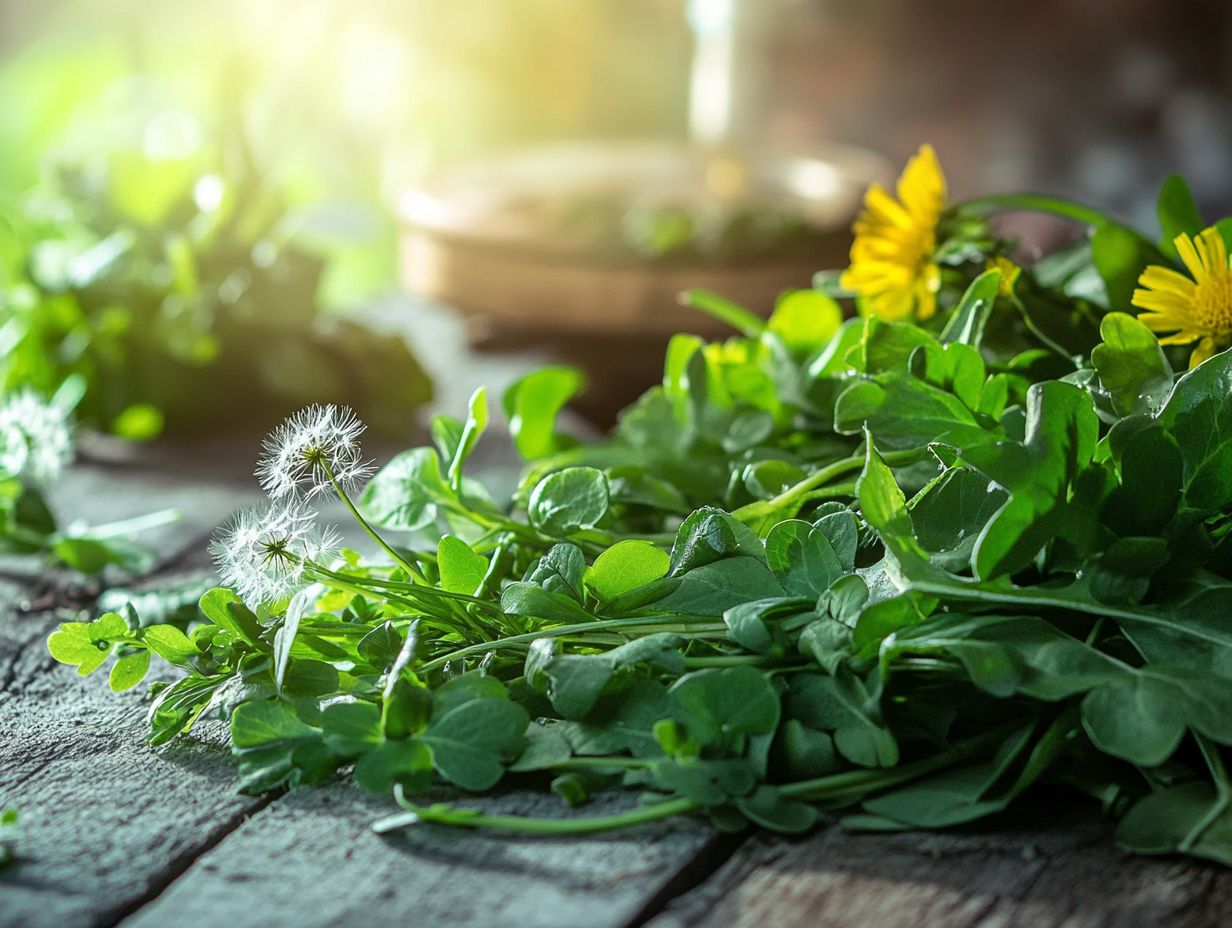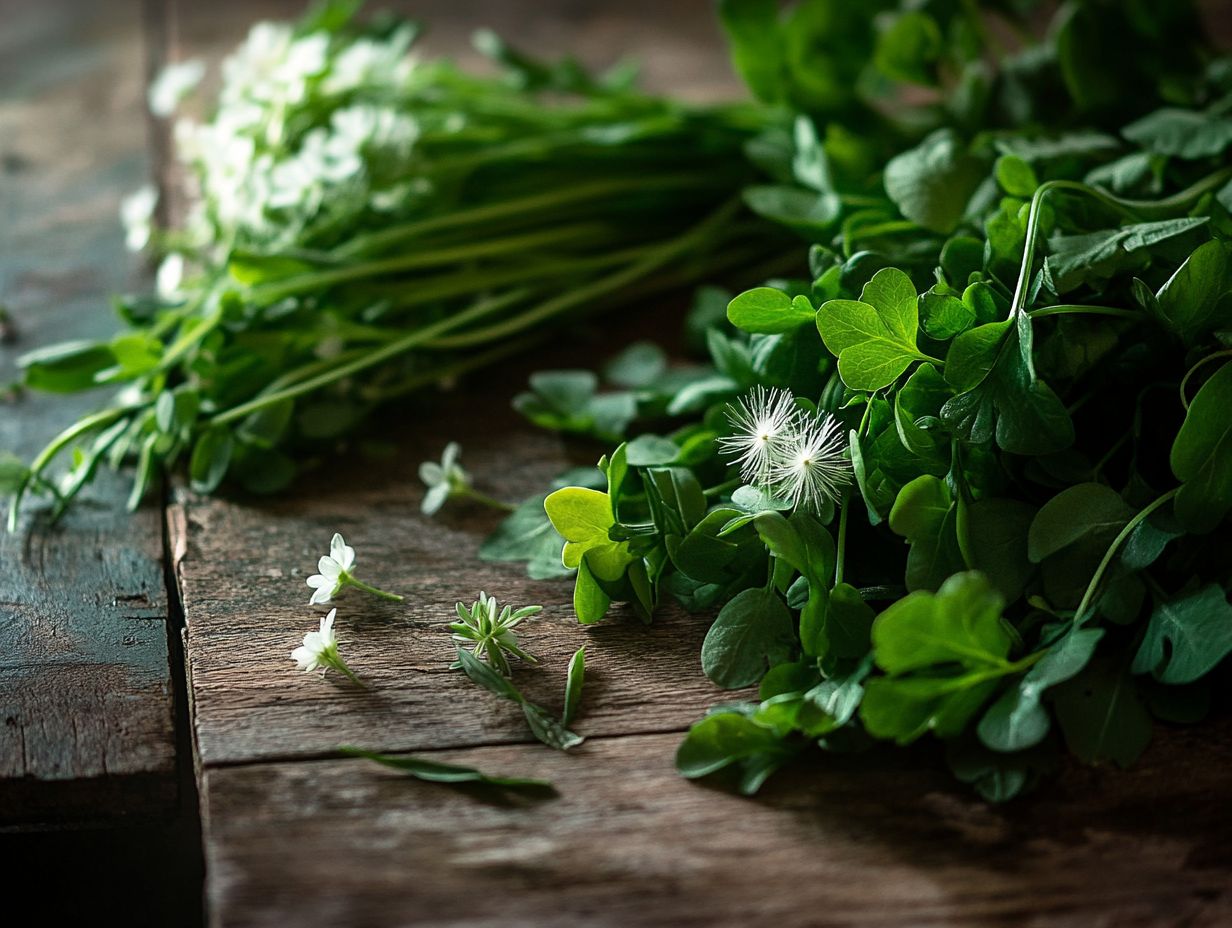Identifying Edible Plants in Your Region
Dive into the thrilling world of edible plants, where every discovery is a rewarding adventure!
Imagine enriching your diet with nutrient-dense wild foods while forging a connection with nature. Knowing how to identify and incorporate these plants into your meals is an invaluable skill that enhances your cooking skills.
This article delves into the benefits of wild plants, highlighting key characteristics for safe identification and showcasing common edible varieties found in different regions. You ll also find essential safety precautions, cooking methods, and sustainable foraging tips, all meticulously designed to ensure you re well-prepared for your adventures in the wild.
Contents
- Key Takeaways:
- The Importance of Knowing Edible Plants
- How to Identify Edible Plants
- Common Edible Plants in Different Regions
- Safety Precautions When Foraging for Edible Plants
- Preparing and Cooking Edible Plants
- Tips for Sustainable Foraging
- Frequently Asked Questions
- What are some common edible plants that can be found in my region?
- How can I ensure that the plants I identify as edible are safe to eat?
- What are some ways to identify edible plants in the wild?
- Can I forage for edible plants in any location in my region?
- Is it safe to eat all parts of an edible plant?
- How can I incorporate edible plants into my diet?
Key Takeaways:

- Discover how wild plants boost your health and add delicious variety to your meals!
- Learn to spot safe plants by observing key features like color and smell.
- Before foraging, research which plants are common and safe to consume in your specific region.
The Importance of Knowing Edible Plants
Understanding the significance of identifying edibles is essential for anyone with a passion for foraging. It unlocks a treasure trove of nutritious options that nature has to offer, from succulent wild berries to hearty tree nuts.
This knowledge enriches your diet with a diverse array of flavors while also serving as a vital survival guide, helping you steer clear of any poisonous varieties.
Numerous resources, such as the Missouri Botanical Garden and HomeHarvest LLC, offer valuable insights into plant identification and safe foraging practices, ensuring you’re well-equipped for your adventures in the wild.
Benefits of Incorporating Wild Plants into Your Diet
Incorporating wild edible plants into your diet opens the door to a treasure trove of health benefits, enriching your meals with flavors and nutrients that often go unnoticed in conventional diets.
These plants not only elevate your culinary experiences but also deliver essential vitamins and minerals. Take dandelion greens, for instance; they re brimming with vitamins A, C, and K. Then there s chickweed, which adds a refreshing taste while promoting digestive health. Wood sorrel, with its delightful lemony zing, can elevate your salads and contribute valuable antioxidants.
Foraging offers more than just nourishment. It fosters a profound connection with nature, allowing you to appreciate the environment and understand where your food originates. This interaction cultivates mindfulness in your eating habits and supports local biodiversity by prioritizing the use of natural resources.
How to Identify Edible Plants
Identifying edible plants is a crucial skill for you as a forager, allowing you to safely savor nature’s diverse bounty without the risk of encountering poisonous varieties. Mastering this art requires you to grasp key characteristics of plants and depend on trustworthy resources or guides for identifying wild edible plants in California.
With this knowledge, you can confidently navigate the wild, enriching your experiences with the safe and delightful offerings of the natural world.
Key Characteristics to Look For
When you embark on a foraging adventure, look out for several key characteristics such as leaf shape, flower color, and habitat. These elements can significantly aid in your quest to safely identify nutritious options hidden within the wilderness.
Paying attention to these visual cues is essential, as many edible plants can easily be mistaken for their toxic counterparts. For example, while both may flaunt green leaves, the shape and arrangement can differ considerably, serving as critical indicators of what s safe to eat. Flower color can also provide valuable hints; typically, vibrant blooms may signal potential danger, while more muted tones often indicate a safer choice.
Habitat plays a crucial role as well. Many poisonous species tend to thrive in damp or shaded areas, whereas nutritionally beneficial plants are more frequently found in well-drained, sunny soil. By understanding these traits, you can significantly boost your foraging confidence and make informed choices in nature’s pantry.
Ready to explore? Grab your basket and get foraging today!
Common Edible Plants in Different Regions

Explore the rich tapestry of global foraging, where diverse regions present an array of common edible plants, each contributing to an important practice for culture and nature.
In North America, you might find wild asparagus and hickory nuts gracing your plate. Europe tempts with offerings like dandelion and chickweed.
This variety highlights the abundance of wild edibles and reflects the unique culinary traditions that thrive in different locales.
Examples of Edible Plants in North America, Europe, Asia, and Australia
In North America, you’ll discover a delightful array of wild edibles like wild berries and hickory nuts. Europe presents unique offerings such as wood sorrel and dandelion, showcasing the vibrant diversity of edible plants found across continents. For those interested in foraging, identifying wild edibles in your local area can enhance your culinary adventures.
Asia is a treasure trove of culinary delights, featuring plants like bamboo shoots and lotus roots, both celebrated for their distinct flavors and health benefits. In Africa, you can explore options like moringa, often called a superfood, packed with nutrients, and sour fig, known for its unique taste and nutritional profile.
Each of these edible plants enhances the culinary tapestry of their regions while supporting local ecosystems. They are essential to sustainable practices.
Safety Precautions When Foraging for Edible Plants
Safety is a must when foraging for wild edible plants. The risk of consuming poisonous varieties can have serious health repercussions.
By mastering the art of accurate plant identification and applying essential survival tips, you can navigate the wilderness with confidence. For those interested in foraging, exploring wild edible plants: a beginner’s guide ensures your adventures remain enjoyable and safe.
How to Avoid Poisonous Plants
To steer clear of poisonous plants while foraging, hone your skills in identifying edible varieties and refer to the top local edibles to forage in your area while applying key safety tips:
- Always use the universal edibility test a way to check if a plant is safe to eat whenever you’re uncertain.
- Familiarize yourself with the specific visual traits of common poisonous species, such as leaf shape, flower color, and growth patterns.
- Understand the typical habitats where these dangerous plants thrive, like wetland areas or woodlands.
Remember, not all plants that look similar are safe; close inspection is vital.
Utilizing the universal edibility test offers you a structured approach to assessing unknown plants. By taking these careful precautions, you can fully enjoy the foraging experience while minimizing the chances of accidentally consuming something harmful.
Preparing and Cooking Edible Plants
Preparing and cooking edible plants with care allows you to elevate raw options into flavorful and nutritious meals. Transform wild edibles into true culinary delights.
Mastering techniques like acorn preparation, utilizing various cooking methods, and employing effective preservation strategies enhances not only the flavor but also the longevity of these natural ingredients.
Methods for Cooking and Preserving Wild Plants

You have a wealth of methods at your fingertips for cooking and preserving wild plants, such as:
- Steaming helps retain that vibrant green hue and crisp texture of wild asparagus.
- Saut ing dandelion greens with a hint of garlic and olive oil transforms them into a robust side dish that truly stands out.
- Drying herbs like nettles or purslane preserves their distinctive flavors for later enjoyment.
By embracing these cooking methods and preservation techniques, you ll appreciate the rich complexity and variety that wild edibles offer. Don t miss out on the chance to explore these amazing plants!
Tips for Sustainable Foraging
Sustainable foraging is crucial for preserving natural habitats and ensuring that wild edible plants continue to flourish for future generations. This responsibility urges you to harvest thoughtfully, safeguarding the environment in the process.
By adopting this mindful approach to foraging, you ll enjoy the delicious rewards of nature while actively promoting the health of ecosystems.
How to Harvest Responsibly and Protect the Environment
Harvesting responsibly is at the heart of sustainable foraging. It allows wild edible plants to flourish while maintaining ecological harmony in their environments.
Embrace these practices now! One technique is picking a few plants instead of taking them all, which gives them the chance to regenerate. Following local regulations is equally vital, as these guidelines exist to safeguard both the plants and the ecosystem.
Respecting the natural habitat involves steering clear of overharvesting and being attuned to seasonal cycles. This approach not only helps preserve biodiversity, but also supports the well-being of local wildlife.
By adopting these principles, you can partake in a rewarding practice that showcases the beauty of nature while ensuring its sustainability for future generations.
Frequently Asked Questions
What are some common edible plants that can be found in my region?
- wild berries
- wild onions
- tree nuts
- edible nuts
- dandelion
- chickweed
- wood sorrel
- acorns (for preparation)
How can I ensure that the plants I identify as edible are safe to eat?

It is important to properly identify edible plants and research any unknown ones before consuming them. Consult with a local expert or use reliable resources such as a guide to wild edibles in your backyard to confirm the identity of a plant.
What are some ways to identify edible plants in the wild?
There are several ways to identify plants, such as studying their physical features, leaf and stem patterns, and any distinct smells or colors. You can also use a simple test to check if a plant is safe to eat, a plant identification app, or guidebook for assistance.
Can I forage for edible plants in any location in my region?
While there may be a wide variety of edible plants in your region, it is crucial to take note of any laws or regulations regarding foraging on public or private land. For those interested in foraging, identifying wild edibles throughout the year is essential. Native Americans have long respected these practices, so always ask for permission before foraging on private property.
Is it safe to eat all parts of an edible plant?
No, not all parts of a plant may be safe to consume. Some plants may have edible berries, but their leaves or roots may be toxic. Always research the specific nutritious plants and their parts before consuming them.
How can I incorporate edible plants into my diet?
There are many ways to incorporate raw plants into your diet, such as adding them to salads, making teas or infusions, or using them as a garnish for dishes. You can also find creative recipes online for incorporating wild edible plants into your meals.






